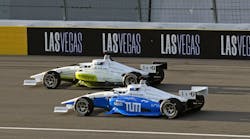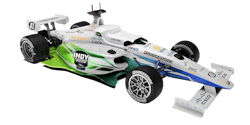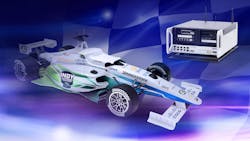Autonomous Racecar Development Helps Train Next Generation of Engineers
There are a number of programs aimed at providing students of all ages with the skills necessary for careers in engineering and related fields, such as the National Fluid Power Association's (NFPA) Fluid Power Vehicle Challenge.
Most recently, The Indy Autonomous Challenge (IAC) took place at the Texas Motor Speedway on November 11. The IAC brings together university students from around the world to program fully autonomous race cars. These vehicles are then put to the test in racing competitions.
The goal of the IAC is to help develop and inspire the next generation of talent for STEM careers, while also advancing technology to speed up commercialization of autonomous vehicles and systems.
With the growing use of automation in a variety of industries, it will be vital to continue engaging and educating the next generation of STEM professionals to advance development of fully autonomous vehicles and the systems which enable them.
READ MORE: How do We Shape the Future Workforce?
Demonstrating the Potential of Autonomous Systems
As part of the IAC, the autonomous race cars are put through a series of matches until a final winner is selected. Per a press release from IAC announcing the winner of the race, it consisted of a single elimination tournament with multiple rounds of head-to-head passing matches culminating in a championship round. The autonomous racecars took turns playing the role of Leader (Defender) and Passer/Follower (Attacker), with passes attempted at ever increasing speeds until one or both cars were unable to successfully complete a pass.
During the November 11 race, teams reached top speeds of 140 mph, demonstrating the capabilities of the vehicles and the students' design skills.
Unseasonably cold and wet weather conditions occurred during the event, causing track temperatures to reach near freezing. While this presented challenges it also demonstrated the ability of the autonomous vehicles to maneuver in these conditions.
“This race was particularly critical for testing under adverse weather conditions, and other track challenges we all encountered,” said Prof. Sergio Savaresi, team lead of Politecnico di Milano, in IAC's press release. “We had the scary, but thrilling, opportunity to see in action our AI (artificial intelligence) driver perform very critical high-speed crash-avoidance maneuvers in both our semi-final and final rounds. The IAC platform pushed boundaries of autonomous driving during this challenge in a direction that can be particularly useful for the safety of future autonomous cars.”
A total of six teams qualified to compete at the Texas Motor Speedway:
- AI Racing Tech - University of Hawai'i (Hawai’i), with University of California, San Diego (California), Carnegie Mellon University (Pennsylvania), and University of California, Berkeley (California)
- KAIST - Korea Advanced Institute of Science and Technology (South Korea)
- MIT-PITT-RW - Massachusetts Institute of Technology (Massachusetts), University of Pittsburgh (Pennsylvania), Rochester Institute of Technology (New York), and University of Waterloo (Canada)
- PoliMOVE - Politecnico di Milano (Italy), University of Alabama (Alabama)
- TII EuroRacing - University of Modena and Reggio Emilia (Italy), Technology Innovation Institute (United Arab Emirates)
- TUM Autonomous Motorsport - Technische Universität München (Germany)
Team PoliMOVE was the ultimate winner, besting AI Racing Tech in the final round.
While the race provided competing teams the opportunity to develop and ultimately test their skills, it also offered an opportunity for the 1,800 local STEM students in attendance to see what could be in their future as well.
Several test and qualifying races are held throughout the year. The next is set to take place during the annual Consumer Electronics Show (CES).
Industry Engagement
The IAC is intended to be a collaborative effort which brings together academic institutions and public-private partnerships. Doing so benefits all involved by providing support to the students and accessibility to the potential future workforce.
Simulation and validation solutions provider dSPACE is one of several companies which supported this year's IAC. It was the Exclusive On-Vehicle Computer Technology Supporter. As such, the company provided its AUTERA AutoBox in-vehicle prototyping and data recording system which aids with the fully autonomous operation of the racecars.
As described by dSPACE, the AUTERA AutoBox is a robust, high-performance central computer that reads and processes sensor data from lidar, radar, and cameras, as well as from automotive buses and networks. It acts as the brain of the racecars by collecting and analyzing all of this data to help ensure safe and appropriate maneuvers are taken by the autonomous racecars.
The official vehicle of the IAC is the AV-21 from racecar manufacturer Dallara. It was retrofit by the company with hardware and controls to enable the use of automation
In-vehicle and car-to-trackside connectivity was provided by Cisco via ultra-low latency wireless technology. Cisco technologies utilized include those used in many industries today: Cisco Ultra-Reliable Wireless Backhaul for highly reliable mobile connectivity and Cisco Catalyst Industrial Ethernet switches to connect in-vehicle sensors and on-board computers.
A variety of other companies provided support for this year's IAC as well, demonstrating the benefit seen to helping educate and inspire the next generation of technology developers.
“Our goal is to bring the brightest minds and top innovators of our time together at iconic racetracks around the world to push autonomous driving technology forward,” said Paul Mitchell, president, Indy Autonomous Challenge, in a press release about the event from IAC. “Through complex problem solving and first-of-its-kind engineering, our teams work with leading industry sponsors like Cisco to advance technology that will speed the commercialization of fully autonomous vehicles and deployments of advanced driver-assistance systems (ADAS).”
Through initiatives like the IAC, there is the potential to help inspire those looking to go into engineering or other STEM related careers. As our 2022 Salary & Career Survey indicated, many believe there is an engineering shortage so being able to provide opportunities to students of all ages to see and be involved with projects similar to what they could work on in the future will benefit the continued progress of technology.
We want to hear from you!
What initiatives are you seeing to help inspire and teach the next generation of engineers? How are you or your company involved with helping inspire future STEM professionals? What more could industry be doing to help?
Let us know! Email me at [email protected] or reach out to us on social media.
Twitter: @TechnlgyEditor or @PowerMotionTech
LinkedIn: @PowerMotionTech




